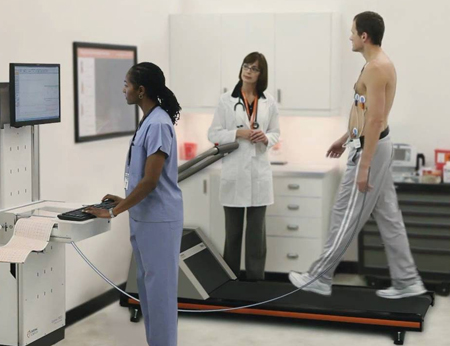TMT

TMT stands for Treadmill Stress Test (also known as exercise stress test), which is a type of stress test performed to determine and evaluate how well your heart responds to exertion. As the name suggests, the patient is made to run on a treadmill (or a stationary bike) to induce exertion and an electrocardiogram (EKG) machine is used to monitor the heart rate. The patient needs to exercise for at least 10 to 15 minutes during which vital signs like blood oxygen level, blood pressure and heart rate are calculated. The test helps to assess and compare the blood circulation in the heart when you are in a resting state to when you are under the influence of optimum physical strain.
Why is the test performed?
TMT can be recommended for any of the following reason:
- To detect any abnormality or obstruction in the coronary artery
- To diagnose arrhythmia
- To determine a treatment plan for various heart problems as well as to check the progress of the same.
- To determine the cause of symptoms like angina, breathlessness and chest discomfort.
- To find out if the patient is eligible for a cardiac rehabilitation programme
- To assess chronotropic competence
- To predict the risks of cardiac arrest.
Contra-indications of TMT
TMT is not recommended to patients with any of the following conditions:
- Acute myocardial infarction (including the presence of new LBBBi.e. left bundle branch block)
- Unstable angina with high risks
- Severe aortic stenosis that is symptomatic
- Severe arrhythmia which is symptomatic
- Haemodynamic instability due to severe arrhythmia
- Acute pulmonary embolus
- Acute aortic dissection
Risks involved
TMT is a significantly safe test as this does not require any incision or use of contrast dye. The test is performed under the supervision of trained professionals in a controlled environment. However, there might be slight risks of the following:
- Chest pain
- Fainting or collapsing
- Heart attack (quite rare)
- Temporary arrhythmia
In order to avoid these complications, doctors evaluate the patient’s condition beforehand and proceed accordingly.
Preparing for a treadmill stress test
- A proper physical evaluation may be required prior to the test during which the patient’s medical history is also assessed. Patients suffering from arthritis and diabetes need to inform their doctors about the same.
- Patients are required to fast for at least 3 hours prior to the test.
- Patients who are on any medication or supplements need to inform the doctor as the same. No medication should be stopped without consulting the doctor.
Procedure
TMT is performed to determine vital signs like heart rate, blood pressure, breathing rate and stamina of the patient under different levels of physical exertion. An electrocardiogram test is performed alongside to trace the heart’s electrical activity.
- The patient is hooked to EKG machine with the help of sticky pads that are directly placed on the patient’s chest, arms, shoulders and legs. A blood pressure cuff is also wrapped the patient’s arm to monitor any fluctuation during the test.
- Patient’s vitals are recorded before initiating the exercise (at a resting state)
- The patient is asked to walk slowly on the treadmill and the pace is increased gradually.
- In case the patient experiences any pain or discomfort, they can ask the doctor to halt the test.
- Once the readings have been taken, the exercise is stopped and the patient is asked to take rest.
Results
Treadmill stress test may present any of the following results:
- Normal blood flow during exertion and while at rest, indicating that everything is normal
- Normal blood flow while resting but not during exertion, indicating blockage or obstruction in the arteries.
- Alleviated blood circulation during exertion and while at rest, indicating the prevalence of coronary artery disease.
- Significantly low or completely no dye in some parts of the heart, indicating tissue damage.
Once the problem has been diagnosed, further tests are ordered and a proper treatment plan is curated to yield the best results for the patient.
What follows?
After the readings have been recorded, the patient is asked to drink water and take rest for some time. If the patient’s blood pressure fluctuated during the test, the nurse may continue to monitor it until it is back to normal.


